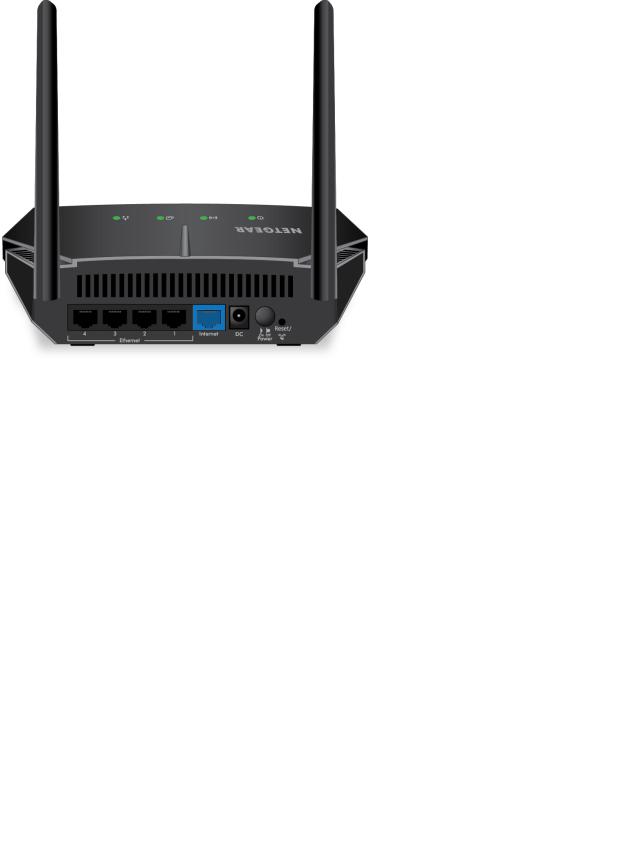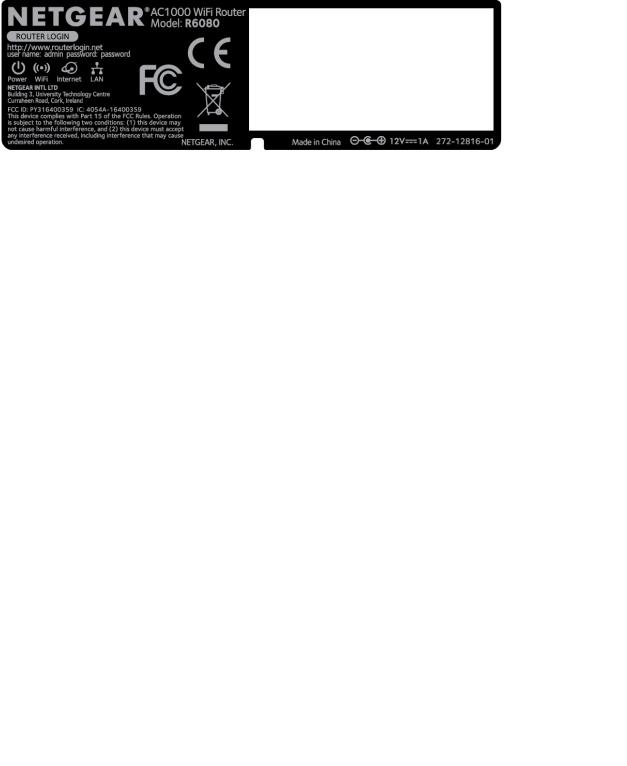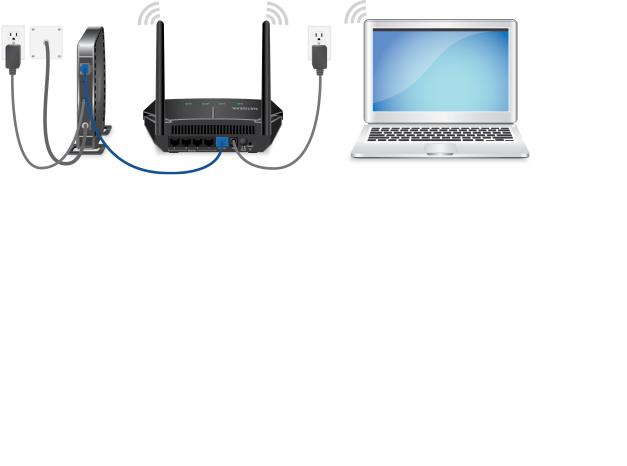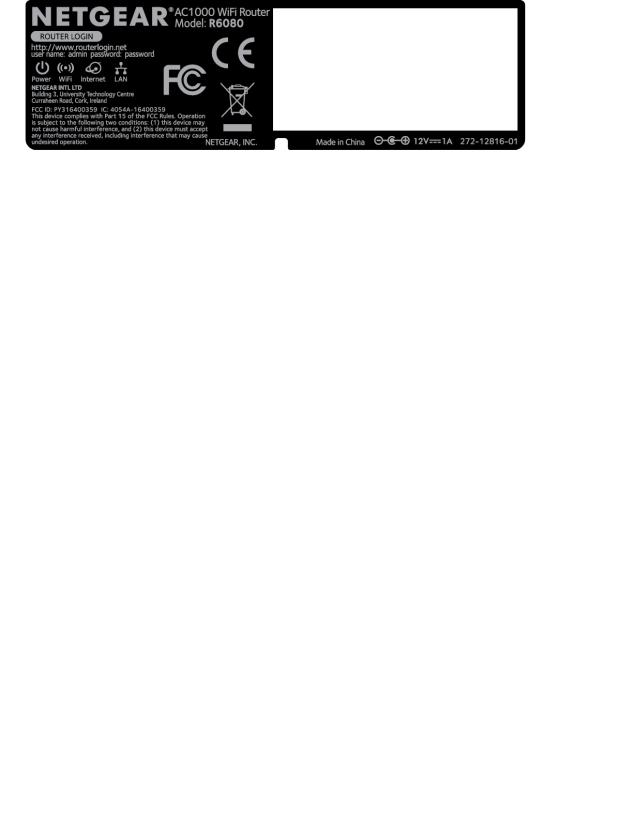Netgear R6080 User Manual

AC1000 WiFi Router
User Manual
Model R6080
September 2017 202-11754-02
350 E. Plumeria Drive
San Jose, CA 95134
USA

AC1000 WiFi Router Model R6080
Support
Thank you for purchasing this NETGEAR product. You can visit www.netgear.com/support to register your product, get help, access the latest downloads and user manuals, and join our community. We recommend that you use only official NETGEAR support resources.
Conformity
For the current EU Declaration of Conformity, visit http://kb.netgear.com/app/answers/detail/a_id/11621.
Compliance
For regulatory compliance information, visit http://www.netgear.com/about/regulatory.
See the regulatory compliance document before connecting the power supply.
Trademarks
© NETGEAR, Inc., NETGEAR, and the NETGEAR Logo are trademarks of NETGEAR, Inc. Any non-NETGEAR trademarks are used for reference purposes only.
2

Contents
Chapter 1 Hardware Overview of the Router |
|
Unpack Your Router............................................................................................... |
8 |
LED Descriptions................................................................................................... |
9 |
Ports, Buttons, and Connectors on the Back Panel............................................... |
9 |
Router Label........................................................................................................ |
11 |
Position the Router............................................................................................... |
11 |
Cable Your Router................................................................................................ |
12 |
Chapter 2 Connect to the Network and Access the Router |
|
Connect to the Router.......................................................................................... |
14 |
Connect to the Router Through an Ethernet Cable......................................... |
14 |
Join the WiFi Network of the Router................................................................ |
14 |
Manual Method........................................................................................... |
14 |
Wi-Fi Protected Setup Method................................................................... |
15 |
Types of Logins............................................................................................... |
15 |
Use a Web Browser to Access the Router........................................................... |
16 |
Automatic Internet Setup................................................................................. |
16 |
Log In to the Router........................................................................................ |
17 |
Change the Language......................................................................................... |
17 |
Access the Router With the NETGEAR genie App.............................................. |
18 |
Chapter 3 Specify Your Internet Settings |
|
Use the Internet Setup Wizard............................................................................. |
20 |
Manually Set Up the Internet Connection............................................................ |
20 |
Specify an Internet Connection Without a Login............................................. |
20 |
Specify an Internet Connection That Uses a Login and PPPoE Service........ |
21 |
Specify an Internet Connection That Uses a Login and PPTP Service........... |
23 |
Specify an Internet Connection That Uses a Login and L2TP Service........... |
24 |
Specify an IPv6 Internet Connection.................................................................... |
25 |
IPv6 Internet Connections and IPv6 Addresses.............................................. |
25 |
Use Auto Detect for an IPv6 Internet Connection........................................... |
26 |
Use Auto Config for an IPv6 Internet Connection........................................... |
27 |
Set Up an IPv6 6to4 Tunnel Internet Connection............................................ |
28 |
Set Up an IPv6 Pass-Through Internet Connection........................................ |
29 |
Set Up a Fixed IPv6 Internet Connection........................................................ |
30 |
Set Up an IPv6 DHCP Internet Connection.................................................... |
31 |
Set Up an IPv6 PPPoE Internet Connection................................................... |
32 |
Manage the MTU Size......................................................................................... |
34 |
MTU Concepts................................................................................................ |
34 |
Change the MTU Size..................................................................................... |
35 |
3

AC1000 WiFi Router Model R6080
Chapter 4 Control Access to the Internet |
|
Set Up Parental Controls..................................................................................... |
37 |
Allow or Block Access to Your Network................................................................ |
38 |
Enable and Manage Network Access Control................................................. |
38 |
Manage Network Access Control Lists........................................................... |
39 |
Add Devices to or Remove Them From the Allowed List............................ |
40 |
Add Devices to or Remove Them From the Blocked List............................ |
41 |
Use Keywords to Block Internet Sites.................................................................. |
42 |
Set Up Blocking............................................................................................... |
42 |
Remove a Keyword or Domain From the Blocked List.................................... |
43 |
Remove All Keywords and Domains From the Blocked List............................ |
43 |
Specify a Trusted Computer............................................................................ |
44 |
Set Up a Schedule for Keyword Blocking and Outbound Firewall Rules............. |
44 |
Chapter 5 Manage the Basic WiFi Network Settings |
|
Manage the Basic WiFi Settings and WiFi Security of the Main Network............ |
47 |
View or Change the Basic WiFi Settings and WiFi Security Settings.............. |
47 |
Configure WEP Legacy WiFi Security............................................................. |
52 |
Configure WPA/WPA2 Enterprise WiFi Security.............................................. |
53 |
Use WPS to Add a Device to the WiFi Network................................................... |
55 |
Use WPS With the Push Button Method......................................................... |
55 |
Use WPS With the PIN Method....................................................................... |
56 |
Manage the Basic WiFi Settings and WiFi Security of the Guest Network.......... |
57 |
Enable or Disable the WiFi Radios....................................................................... |
60 |
Chapter 6 Manage the WAN and LAN Network Settings |
|
Manage the WAN Security Settings..................................................................... |
63 |
Set Up a Default DMZ Server.............................................................................. |
63 |
Manage IGMP Proxying....................................................................................... |
64 |
Manage VPN Pass-Through................................................................................ |
65 |
Manage NAT Filtering.......................................................................................... |
65 |
Manage the SIP Application-Level Gateway........................................................ |
66 |
Manage the LAN IP Address Settings................................................................. |
66 |
Manage the Router Information Protocol Settings............................................... |
67 |
Manage the DHCP Server Address Pool............................................................. |
68 |
Manage Reserved LAN IP Addresses................................................................. |
69 |
Reserve a LAN IP Address............................................................................. |
69 |
Change a Reserved IP Address...................................................................... |
70 |
Remove a Reserved IP Address Entry............................................................ |
70 |
Disable the Built-In DHCP Server........................................................................ |
71 |
Change the Router’s Device Name...................................................................... |
71 |
Set Up and Manage Custom Static Routes......................................................... |
72 |
Set Up a Static Route...................................................................................... |
73 |
Change a Static Route.................................................................................... |
74 |
Remove a Static Route................................................................................... |
74 |
Set Up a Bridge for a Port Group or VLAN Tag Group......................................... |
75 |
Set Up a Bridge for a Port Group.................................................................... |
75 |
4

AC1000 WiFi Router Model R6080
Set Up a Bridge for a VLAN Tag Group........................................................... |
76 |
Improve Network Connections With Universal Plug-N-Play................................. |
78 |
Chapter 7 Manage the Router |
|
Update the Firmware of the Router...................................................................... |
80 |
Check for New Firmware and Update the Router............................................ |
80 |
Manually Upload New Firmware and Update the Router................................ |
81 |
Change the admin Password............................................................................... |
82 |
Set Up Password Recovery................................................................................. |
83 |
Recover the admin Password.............................................................................. |
83 |
Manage the Configuration File of the Router....................................................... |
84 |
Back Up the Settings....................................................................................... |
84 |
Restore the Settings........................................................................................ |
84 |
Return the Router to Its Factory Default Settings................................................ |
85 |
Use the Reset Button...................................................................................... |
85 |
Erase the Settings........................................................................................... |
86 |
View the Status and Statistics of the Router........................................................ |
87 |
View Information About the Router and the Internet and WiFi Settings.......... |
87 |
Display Internet Port Statistics........................................................................ |
87 |
Check the Internet Connection Status............................................................ |
88 |
Manage the Activity Log....................................................................................... |
89 |
View, Email, or Clear the Logs........................................................................ |
89 |
Specify Which Activities Are Logged............................................................... |
90 |
View Devices Currently on the Network............................................................... |
90 |
Chapter 8 Manage the Advanced WiFi Features |
|
Set Up a WiFi Schedule....................................................................................... |
93 |
Manage the WPS Settings................................................................................... |
93 |
Manage Advanced WiFi Settings......................................................................... |
94 |
Use the Router as a WiFi Access Point Only....................................................... |
95 |
Chapter 9 Manage Port Forwarding and Port Triggering |
|
Manage Port Forwarding to a Local Server for Services and Applications.......... |
98 |
Forward Incoming Traffic for a Default Service or Application......................... |
98 |
Add a Port Forwarding Rule With a Custom Service or Application................ |
99 |
Change a Port Forwarding Rule.................................................................... |
100 |
Remove a Port Forwarding Rule................................................................... |
101 |
Application Example: Make a Local Web Server Public................................ |
101 |
How the Router Implements the Port Forwarding Rule................................. |
102 |
Manage Port Triggering for Services and Applications...................................... |
102 |
Add a Port Triggering Rule............................................................................ |
103 |
Change a Port Triggering Rule...................................................................... |
104 |
Remove a Port Triggering Rule..................................................................... |
105 |
Specify the Time-Out for Port Triggering....................................................... |
105 |
Disable Port Triggering.................................................................................. |
106 |
Application Example: Port Triggering for Internet Relay Chat........................ |
106 |
5

AC1000 WiFi Router Model R6080
Chapter 10 Troubleshooting |
|
Reboot the Router From Its Web Interface......................................................... |
109 |
Quick Tips.......................................................................................................... |
109 |
Sequence to Restart Your Network............................................................... |
109 |
Check Ethernet Cable Connections.............................................................. |
109 |
WiFi Settings................................................................................................. |
110 |
Network Settings........................................................................................... |
110 |
Troubleshoot With the LEDs............................................................................... |
110 |
Standard LED Behavior When the Router Is Powered On............................ |
110 |
Power LED Is Off or Blinking......................................................................... |
110 |
Power LED Stays Amber............................................................................... |
111 |
Internet or Ethernet LEDs Are Off................................................................. |
111 |
WiFi LED Is Off.............................................................................................. |
111 |
You Cannot Log In to the Router........................................................................ |
111 |
You Cannot Access the Internet......................................................................... |
112 |
Check the WAN IP Address........................................................................... |
112 |
Troubleshoot PPPoE..................................................................................... |
113 |
Troubleshoot Internet Browsing..................................................................... |
114 |
Changes Are Not Saved.................................................................................... |
114 |
Troubleshoot WiFi Connectivity.......................................................................... |
115 |
Troubleshoot Your Network Using the Ping Utility.............................................. |
115 |
Test the LAN Path to Your Router.................................................................. |
115 |
Test the Path From Your Computer to a Remote Device............................... |
116 |
Appendix A Supplemental Information |
|
Factory Settings................................................................................................. |
118 |
Technical Specifications..................................................................................... |
121 |
6

Hardware Overview of the Router |
1 |
|
This chapter contains the following sections:
•Unpack Your Router on page 8
•LED Descriptions on page 9
•Ports, Buttons, and Connectors on the Back Panel on page 9
•Router Label on page 11
•Position the Router on page 11
•Cable Your Router on page 12
For more information about the topics that are covered in this manual, visit the support website at netgear.com/support.
Firmware updates with new features and bug fixes are made available from time to time at downloadcenter.netgear.com.You can check for and download new firmware manually. If the features or behavior of your product does not match what is described in this guide, you might need to update your firmware.
In this manual, the terms wireless and WiFi are interchangeable.
7

AC1000 WiFi Router Model R6080
Unpack Your Router
The box contains the following items.
Figure 1. Package contents
Table 1. Legend
 1.
1.  Router
Router
2. Ethernet cable
 3.
3.  Power adapter
Power adapter
In some regions, a CD is included in the package.
Hardware Overview of the Router
8

AC1000 WiFi Router Model R6080
LED Descriptions
The following table describes the LEDs on the router.
Table 2. LED descriptions
LED |
Description |
Power LED |
Solid green. The power is on, and the router is ready. |
|
Blinking green. A firmware update is in progress. |
|
Off. Power is not supplied to the router. |
WiFi LED |
Solid green. The wireless radio is operating. |
|
Off. The wireless radio is off. |
Internet LED |
Solid green. The Internet connection is ready. |
|
Off. No Ethernet cable is connected between the router and the modem. |
Ethernet ports 1–4 Solid green. A powered-on device is connected to the Ethernet port.
LED
Off. No device is connected to this Ethernet port.
Ports, Buttons, and Connectors on the Back Panel
The back panel of the router provides ports, buttons, and a DC power connector.
Hardware Overview of the Router
9

AC1000 WiFi Router Model R6080
Figure 2. Router back panel
In addition to the two antennas, the back panel contains the following components:
•Reset/WPS button. This button can be used to reboot and reset the router and connect WPS-enabled devices to the router depending on how long the button is pressed:
-Reboot the router. Press the button for less than 5 seconds to reboot the router.
-Connect WPS-enabled devices. Press the button for about 5 to 10 seconds until the WiFi LED blinks amber.
-Reset the router to its factory default settings. Press the button for more than 10 seconds until all the LEDs blink green.
•Ethernet LAN ports. Use the four Fast Ethernet RJ-45 LAN ports to connect the router to LAN devices.
•Internet WAN port. Use the blue Fast Ethernet RJ-45 WAN port to connect the router to a modem.
•Power On/Off button. Press the Power On/Off button to provide power to the router.
•DC power connector. Connect the power adapter that came in the product package to the DC power connector.
Hardware Overview of the Router
10

AC1000 WiFi Router Model R6080
Router Label
The router label on the bottom panel of the router lists the login information, WiFi network name (SSID) and password (network key), serial number, and MAC address of the router.
Figure 3. Router label
Position the Router
The router lets you access your network anywhere within the operating range of your WiFi network. However, the operating distance or range of your WiFi connection can vary significantly depending on the physical placement of the router. For example, the thickness and number of walls the WiFi signal passes through can limit the range.
Additionally, other WiFi access points in and around your home might affect your router’s signal. WiFi access points are routers, repeaters, WiFi range extenders, and any other device that emits a WiFi signal for network access.
Position the router according to the following guidelines:
•Place the router near the center of the area where your computers and other devices operate and within line of sight to your WiFi devices.
•Make sure that the router is within reach of an AC power outlet and near Ethernet cables for wired computers.
•Place the router in an elevated location, minimizing the number walls and ceilings between the router and your other devices.
•Place the router away from electrical devices such as these:
-Ceiling fans
-Home security systems
-Microwaves
-Computers
-Base of a cordless phone
Hardware Overview of the Router
11

AC1000 WiFi Router Model R6080
-2.4 GHz cordless phone
-5 GHz cordless phone
•Place the router away from large metal surfaces, large glass surfaces, insulated walls, and items such as these:
-Solid metal door
-Aluminum studs
-Fish tanks
-Mirrors
-Brick
-Concrete
If you are using adjacent access points, use different radio frequency channels to reduce interference.
Cable Your Router
The following image shows how to cable your router:
Figure 4. Router cabling
 To cable your router:
To cable your router:
1.Unplug your modem’s power, leaving the modem connected to the wall jack for your Internet service. If your modem uses a battery backup, remove the battery.
2.Plug in and turn on your modem.
If your modem uses a battery backup, put the battery back in.
3.Connect your modem to the Internet port of your router with the blue Ethernet cable that came with your router.
4.Connect the power adapter to your router and plug the power adapter into an outlet.
5.If the Power LED does not light, press the Power On/Off button on the back panel of the router.
Hardware Overview of the Router
12

Connect to the Network and Access the |
2 |
Router |
You can connect to the router’s WiFi networks or use a wired Ethernet connection. This chapter describes the ways you can connect and how to access the router and log in.
The chapter contains the following sections:
•Connect to the Router on page 14
•Use a Web Browser to Access the Router on page 16
•Change the Language on page 17
•Access the Router With the NETGEAR genie App on page 18
13

AC1000 WiFi Router Model R6080
Connect to the Router
During and after installation, you can connect to the router’s network through a wired or WiFi connection. If you set up your computer to use a static IP address, change the settings of your computer so that it uses Dynamic Host Configuration Protocol (DHCP).
Connect to the Router Through an Ethernet Cable
You can connect your computer to the router using an Ethernet cable and join the router’s local area network (LAN).
 To connect your computer to the router with an Ethernet cable:
To connect your computer to the router with an Ethernet cable:
1.Make sure that the router is receiving power (its Power LED is lit).
2.Connect an Ethernet cable to an Ethernet port on your computer.
3.Connect the other end of the Ethernet cable to one of the numbered Ethernet ports.
Your computer connects to the local area network (LAN). A message might display on your computer screen to notify you that an Ethernet cable is connected.
Join the WiFi Network of the Router
Choose either the manual or the WPS method to add a WiFi device such as a WiFi-enabled computer, an iPhone, an iPad, another mobile device, or a gaming device to the WiFi network of the router.
Manual Method
On the WiFi device that you want to connect to the router, you can use the software application that manages your WiFi connections.
 To connect a device manually to the WiFi network of the router:
To connect a device manually to the WiFi network of the router:
1.Make sure that the router is receiving power (its Power LED is lit).
2.On the WiFi device that you want to connect to your router, open the software application that manages your WiFi connections.
This software scans for all WiFi networks in your area.
3.Look for the router’s network and select it.
Connect to the Network and Access the Router
14

AC1000 WiFi Router Model R6080
If you did not change the name of the network during the setup process, look for the default WiFi network name (SSID) and select it. The default SSID is on the router label.
4.Enter the router WiFi password.
The default WiFi password (also referred to as the network key or passphrase) is also on the router label.
5.Click the Connect button.
The device connects to the WiFi network of the router.
Wi-Fi Protected Setup Method
Wi-Fi Protected Setup (WPS) is a standard for easily adding computers and other devices to a home network while maintaining security. To use WPS (Push 'N' Connect), make sure that all WiFi devices to be connected to the network are Wi-Fi certified and support WPS. During the connection process, the client gets the security settings from the router so that every device in the network supports the same security settings.
 To use WPS to connect a computer or mobile device to the WiFi network of the router:
To use WPS to connect a computer or mobile device to the WiFi network of the router:
1.Make sure that the router is receiving power (its Power LED is lit).
2.Check the WPS instructions for your computer or mobile device.
3.Press the Reset/WPS button of the router for about 5 to 10 seconds until the WiFi LED blinks amber.
4.Within two minutes, press the WPS button on your computer or mobile device, or follow the WPS instructions that came with the device.
The WPS process automatically sets up the device with the network password and connects the device to the WiFi network of the router.
For more information, see Use WPS to Add a Device to the WiFi Network on page 55.
Types of Logins
Separate types of logins serve different purposes. It is important that you understand the difference so that you know which login to use when.
Several types of logins are associated with the router:
Connect to the Network and Access the Router
15

AC1000 WiFi Router Model R6080
•ISP login. The login that your ISP gave you logs you in to your Internet service. Your service provider gave you this login information in a letter or some other way. If you cannot find this login information, contact your service provider.
•WiFi network key or password. Your router is preset with a unique WiFi network name (SSID) and password for WiFi access. This information is on the router label.
•Router login. This logs you in to the router interface from a web browser as admin.
Use a Web Browser to Access the Router
When you connect to the network (either with WiFi or with an Ethernet cable), you can use a web browser to access the router to view or change its settings. When you access the router, the software automatically checks to see if your router can connect to your Internet service.
Automatic Internet Setup
You can set up your router automatically, or you can use a web browser to access the router and set up your router manually. Before you start the setup process, get your ISP information and make sure that the computers and devices in the network are using the settings described here.
When your Internet service starts, your Internet service provider (ISP) typically gives you all the information needed to connect to the Internet. For DSL service, you might need the following information to set up your router:
•The ISP configuration information for your DSL account
•ISP login name and password
•Fixed or static IP address setting (special deployment by ISP; this setting is rare)
If you cannot locate this information, ask your ISP to provide it. When your Internet connection is working, you no longer need to launch the ISP login program on your computer to access the Internet. When you start an Internet application, your router automatically logs you in.
Using the installation assistant, basic setup takes about 15 minutes to complete.
 To automatically set up your router:
To automatically set up your router:
1.Turn the router on by pressing the On/Off button.
2.Make sure that your computer or mobile device is connected to the router with an Ethernet cable (wired) or over WiFi with the preset security settings listed on the label.
Note If you want to change the router’s WiFi settings, use a wired connection to avoid being disconnected when the new WiFi settings take effect.
3.Launch a web browser.
The browser goes to http://www.routerlogin.net and the NETGEAR installation assistant displays.
4.If the browser does not display the NETGEAR installation assistant, enter http://www.routerlogin.net in the address field.
5.Follow the onscreen instructions.
Connect to the Network and Access the Router
16

AC1000 WiFi Router Model R6080
The router connects to the Internet.
6.If the browser does not display the installation assistant page, do the following:
•Make sure that the computer is connected to one of the four LAN Ethernet ports or over WiFi to the router.
•Make sure that the router is receiving power and that its Power LED is lit.
•Close and reopen the browser or clear the browser cache.
•Browse to http://www.routerlogin.net.
•If the computer is set to a static or fixed IP address (this setting is uncommon), change it to obtain an IP address automatically from the router.
7.If the router does not connect to the Internet, do the following:
a.Review your settings.
Make sure that you selected the correct options and typed everything correctly.
b.Contact your ISP to verify that you are using the correct configuration information.
c.Read You Cannot Access the Internet on page 112.
If problems persist, register your NETGEAR product and contact NETGEAR technical support.
Log In to the Router
When you first connect to your router and launch a web browser, the browser automatically displays the router web interface. If you want to view or change settings for the router later, you can use a browser to log in to the router web interface.
 To log in to the router:
To log in to the router:
1.Launch a web browser from a computer or mobile device that is connected to the network.
2.Enter http://www.routerlogin.net.
Note You can also enter http://www.routerlogin.com or http://192.168.1.1.The procedures in this manual use http://www.routerlogin.net.
A login window opens.
3.Enter the router user name and password.
The user name is admin. The default password is password. The user name and password are case-sensitive.
The BASIC Home page displays.
Change the Language
By default, the language is set as Auto. You can change the language.
Connect to the Network and Access the Router
17

AC1000 WiFi Router Model R6080
 To change the language:
To change the language:
1.Launch a web browser from a computer or mobile device that is connected to the network.
2.Enter http://www.routerlogin.net. A login window opens.
3.Enter the router user name and password.
The user name is admin. The default password is password. The user name and password are case-sensitive.
The BASIC Home page displays.
4.In the upper right corner, select a language from the menu.
5.When prompted, click the OK button to confirm this change. The page refreshes with the language that you selected.
Access the Router With the NETGEAR genie App
The NETGEAR genie® app is the easy dashboard for managing, monitoring, and repairing your home network. The app also includes remote access, which lets you manage your network away from home.
 To use the genie app to access the router:
To use the genie app to access the router:
1.Visit the NETGEAR genie web page at netgear.com/genie.
2.Click the appropriate Download button.
3.Follow the onscreen instructions to install the app on your smartphone, tablet, or WiFi-enabled computer.
4.Launch the genie app.
The genie app dashboard displays.
Connect to the Network and Access the Router
18

Specify Your Internet Settings |
3 |
|
Usually, the quickest way to set up the router to use your Internet connection is to allow the NETGEAR installation assistant to detect the Internet connection when you first access the router with a web browser. You can also customize or specify your Internet settings.
This chapter contains the following sections:
•Use the Internet Setup Wizard on page 20
•Manually Set Up the Internet Connection on page 20
•Specify an IPv6 Internet Connection on page 25
•Manage the MTU Size on page 34
19

AC1000 WiFi Router Model R6080
Use the Internet Setup Wizard
You can use the Setup Wizard to detect your Internet settings and automatically set up your router. The Setup Wizard is not the same as the installation assistant pages that displays the first time you connect to your router to set it up.
 To use the Setup Wizard:
To use the Setup Wizard:
1.Launch a web browser from a computer or mobile device that is connected to the network.
2.Enter http://www.routerlogin.net. A login window opens.
3.Enter the router user name and password.
The user name is admin. The default password is password. The user name and password are case-sensitive.
The BASIC Home page displays.
4.Select ADVANCED > Setup Wizard. The Setup Wizard page displays.
5.Select the Yes radio button.
If you select the No radio button, you are taken to the Internet Setup page (see Manually Set Up the Internet Connection on page 20).
6.Click the Next button.
The Setup Wizard searches your Internet connection for servers and protocols to determine your Internet configuration.
Manually Set Up the Internet Connection
You can view or change the router’s Internet connection settings.
Specify an Internet Connection Without a Login
You can manually specify the connection settings for an Internet service for which you do not need to log in.
Use the information that your ISP gave you to connect to your Internet service. If you cannot find this information, contact your ISP. Entering incorrect information might prevent the router from connecting to the Internet.
 To specify the connection settings for an Internet service for which you do not need to log in:
To specify the connection settings for an Internet service for which you do not need to log in:
1.Launch a web browser from a computer or mobile device that is connected to the network.
2.Enter http://www.routerlogin.net. A login window opens.
Specify Your Internet Settings
20

AC1000 WiFi Router Model R6080
3.Enter the router user name and password.
The user name is admin. The default password is password. The user name and password are case-sensitive.
The BASIC Home page displays.
4.Select Internet.
The Internet Setup page displays.
5.Leave the Does your Internet connection require a login? No radio button selected.
6.If your Internet connection requires an account name or host name, type it in the Account Name (If Required) field.
7.If your Internet connection requires a domain name, type it in the Domain Name (If Required) field. For the other sections on this page, the default settings usually work, but you can change them.
8.Select an Internet IP Address radio button:
•Get Dynamically from ISP.Your ISP uses DHCP to assign your IP address.Your ISP automatically assigns these addresses.
•Use Static IP Address. Enter the IP address, IP subnet mask, and the gateway IP address that your ISP assigned. The gateway is the ISP router to which your router connects.
9.Select a Domain Name Server (DNS) Address radio button:
•Get Automatically from ISP. Your ISP uses DHCP to assign your DNS servers. Your ISP automatically assigns this address.
•Use These DNS Servers. If you know that your ISP requires specific servers, select this option. Enter the IP address of your ISP’s primary DNS server. If a secondary DNS server address is available, enter it also.
10.Select a Router MAC Address radio button:
•Use Default Address. Use the default MAC address.
•Use Computer MAC Address. The router captures and uses the MAC address of the computer
that you are now using. You must use the one computer that the ISP allows.
• Use This MAC Address. Enter the MAC address that you want to use.
11.Click the Apply button. Your settings are saved.
12.Click the Test button to test your Internet connection.
Specify an Internet Connection That Uses a Login and PPPoE
Service
You can manually specify the connection settings for a PPPoE Internet service for which you must log in. Use the information that your ISP gave you to connect to your Internet service. If you cannot find this information, contact your ISP. Entering incorrect information might prevent the router from connecting to the Internet.
Specify Your Internet Settings
21

AC1000 WiFi Router Model R6080
 To specify the connection settings for a PPPoE Internet service for which you must log in:
To specify the connection settings for a PPPoE Internet service for which you must log in:
1.Launch a web browser from a computer or mobile device that is connected to the network.
2.Enter http://www.routerlogin.net. A login window opens.
3.Enter the router user name and password.
The user name is admin. The default password is password. The user name and password are case-sensitive.
The BASIC Home page displays.
4.Select Internet.
The Internet Setup page displays.
5.Select the Does your Internet connection require a login? Yes radio button. The page adjusts.
6.From the Internet Service Provider menu, select PPPoE as the encapsulation method. The page adjusts.
7.In the Login field, enter the login name that your ISP gave you. This login name is often an email address.
8.In the Password field, type the password that you use to log in to your Internet service.
9.If your ISP requires a service name, type it in the Service Name (if Required) field.
10.From the Connection Mode menu, select Always On, Dial on Demand, or Manually Connect.
11.To change the number of minutes until the Internet login times out, in the Idle Timeout (In minutes) field, type the number of minutes.
This is how long the router keeps the Internet connection active when no one on the network is using the Internet connection. A value of 0 (zero) means never log out.
12.Select an Internet IP Address radio button:
•Get Dynamically from ISP.Your ISP uses DHCP to assign your IP address.Your ISP automatically assigns these addresses.
•Use Static IP Address. Enter the IP address, IP subnet mask, and the gateway IP address that your ISP assigned. The gateway is the ISP router to which your router connects.
13.Select a Domain Name Server (DNS) Address radio button:
•Get Automatically from ISP. Your ISP uses DHCP to assign your DNS servers. Your ISP automatically assigns this address.
•Use These DNS Servers. If you know that your ISP requires specific servers, select this option. Enter the IP address of your ISP’s primary DNS server. If a secondary DNS server address is available, enter it also.
14.Select a Router MAC Address radio button:
•Use Default Address. Use the default MAC address.
•Use Computer MAC Address. The router captures and uses the MAC address of the computer that you are now using. You must use the one computer that the ISP allows.
Specify Your Internet Settings
22

AC1000 WiFi Router Model R6080
• Use This MAC Address. Enter the MAC address that you want to use.
15.Click the Apply button. Your settings are saved.
16.Click the Test button to test your Internet connection.
If the NETGEAR website does not display within one minute, see You Cannot Access the Internet on page 112.
Specify an Internet Connection That Uses a Login and PPTP
Service
You can manually specify the connection settings for a PPTP Internet service for which you must log in. Use the information that your ISP gave you to connect to your Internet service. If you cannot find this information, contact your ISP. Entering incorrect information might prevent the router from connecting to the Internet.
 To specify the connection settings for a PPTP Internet service for which you must log in:
To specify the connection settings for a PPTP Internet service for which you must log in:
1.Launch a web browser from a computer or mobile device that is connected to the network.
2.Enter http://www.routerlogin.net. A login window opens.
3.Enter the router user name and password.
The user name is admin. The default password is password. The user name and password are case-sensitive.
The BASIC Home page displays.
4.Select Internet.
The Internet Setup page displays.
5.Select the Does your Internet connection require a login? Yes radio button. The page adjusts.
6.From the Internet Service Provider menu, select PPTP as the encapsulation method. The page adjusts.
7.In the Login field, enter the login name that your ISP gave you. This login name is often an email address.
8.In the Password field, type the password that you use to log in to your Internet service.
9.From the Connection Mode menu, select Always On, Dial on Demand, or Manually Connect.
10.To change the number of minutes until the Internet login times out, in the Idle Timeout (In minutes) field, type the number of minutes.
This is how long the router keeps the Internet connection active when no one on the network is using the Internet connection. A value of 0 (zero) means never log out.
Specify Your Internet Settings
23

AC1000 WiFi Router Model R6080
11.If your ISP gave you fixed IP addresses and a connection ID or name, type them in the My IP Address,
Subnet Mask, Server Address, Gateway IP Address, and Connection ID/Name fields.
If your ISP did not give you IP addresses, a connection ID, or name, leave these fields blank.
12.Select a Domain Name Server (DNS) Address radio button:
•Get Automatically from ISP. Your ISP uses DHCP to assign your DNS servers. Your ISP automatically assigns this address.
•Use These DNS Servers. If you know that your ISP requires specific servers, select this option. Enter the IP address of your ISP’s primary DNS server. If a secondary DNS server address is available, enter it also.
13.Select a Router MAC Address radio button:
•Use Default Address. Use the default MAC address.
•Use Computer MAC Address. The router captures and uses the MAC address of the computer
that you are now using. You must use the one computer that the ISP allows.
• Use This MAC Address. Enter the MAC address that you want to use.
14.Click the Apply button. Your settings are saved.
15.Click the Test button to test your Internet connection.
Specify an Internet Connection That Uses a Login and L2TP
Service
You can manually specify the connection settings for an L2TP Internet service for which you must log in. Use the information that your ISP gave you to connect to your Internet service. If you cannot find this information, contact your ISP. Entering incorrect information might prevent the router from connecting to the Internet.
 To specify the connection settings for an L2TP Internet service for which you must log in:
To specify the connection settings for an L2TP Internet service for which you must log in:
1.Launch a web browser from a computer or mobile device that is connected to the network.
2.Enter http://www.routerlogin.net. A login window opens.
3.Enter the router user name and password.
The user name is admin. The default password is password. The user name and password are case-sensitive.
The BASIC Home page displays.
4.Select Internet.
The Internet Setup page displays.
5.Select the Does your Internet connection require a login? Yes radio button. The page adjusts.
6.From the Internet Service Provider menu, select L2TP as the encapsulation method.
Specify Your Internet Settings
24

AC1000 WiFi Router Model R6080
The page adjusts.
7.In the Login field, enter the login name that your ISP gave you. This login name is often an email address.
8.In the Password field, type the password that you use to log in to your Internet service.
9.From the Connection Mode menu, select Always On, Dial on Demand, or Manually Connect.
10.To change the number of minutes until the Internet login times out, in the Idle Timeout (In minutes) field, type the number of minutes.
This is how long the router keeps the Internet connection active when no one on the network is using the Internet connection. A value of 0 (zero) means never log out.
11.If your ISP gave you fixed IP addresses and a connection ID or name, type them in the My IP Address,
IP Subnet Mask, Server Address, and Gateway IP Address fields.
If your ISP did not give you IP addresses, a connection ID, or name, leave these fields blank.
12.Select a Domain Name Server (DNS) Address radio button:
•Get Automatically from ISP. Your ISP uses DHCP to assign your DNS servers. Your ISP automatically assigns this address.
•Use These DNS Servers. If you know that your ISP requires specific servers, select this option. Enter the IP address of your ISP’s primary DNS server. If a secondary DNS server address is available, enter it also.
13.Select a Router MAC Address radio button:
•Use Default Address. Use the default MAC address.
•Use Computer MAC Address. The router captures and uses the MAC address of the computer
that you are now using. You must use the one computer that the ISP allows.
• Use This MAC Address. Enter the MAC address that you want to use.
14.Click the Apply button. Your settings are saved.
15.Click the Test button to test your Internet connection.
Specify an IPv6 Internet Connection
The router supports many different types of IPv6 Internet connections for which you can specify the settings manually.
IPv6 Internet Connections and IPv6 Addresses
The router can support an IPv6 Internet connection through the following connection types:
•Auto Detect. For information, see Use Auto Detect for an IPv6 Internet Connection on page 26.
•Auto Config. For information, see Use Auto Config for an IPv6 Internet Connection on page 27.
•6to4 tunnel. For information, see Set Up an IPv6 6to4 Tunnel Internet Connection on page 28.
Specify Your Internet Settings
25

AC1000 WiFi Router Model R6080
•Pass-through. For information, see Set Up an IPv6 Pass-Through Internet Connection on page 29.
•Fixed. For information, see Set Up a Fixed IPv6 Internet Connection on page 30.
•DHCP. For information, see Set Up an IPv6 DHCP Internet Connection on page 31.
•PPPoE. For information, see Set Up an IPv6 PPPoE Internet Connection on page 32.
Which connection type you must use depends on your IPv6 ISP. Follow the directions that your IPv6 ISP gave you.
•If your ISP did not provide details, use the 6to4 tunnel connection type (see Set Up an IPv6 6to4 Tunnel Internet Connection on page 28).
•If you are not sure what type of IPv6 connection the router uses, use the Auto Detect connection type, which lets the router detect the IPv6 type that is in use (see Use Auto Detect for an IPv6 Internet Connection on page 26).
•If your Internet connection does not use pass-through, a fixed IP address, DHCP, or PPPoE but is IPv6, use the Auto Config connection type, which lets the router autoconfigure its IPv6 connection (see Use Auto Config for an IPv6 Internet Connection on page 27).
When you enable IPv6 and select any connection type other than IPv6 pass-through, the router starts the stateful packet inspection (SPI) firewall function on the WAN interface.The router creates connection records and checks every inbound IPv6 packet. If the inbound packet is not destined to the router itself and the router does not expect to receive such a packet, or the packet is not in the connection record, the router blocks this packet. This function works in two modes: In secured mode, the router inspects both TCP and UDP packets. In open mode, the router inspects UDP packets only.
IPv6 addresses are denoted by eight groups of hexadecimal quartets that are separated by colons. You can reduce any four-digit group of zeros within an IPv6 address to a single zero or omit it. The following errors invalidate an IPv6 address:
•More than eight groups of hexadecimal quartets
•More than four hexadecimal characters in a quartet
•More than two colons in a row
Use Auto Detect for an IPv6 Internet Connection
 To set up an IPv6 Internet connection through autodetection:
To set up an IPv6 Internet connection through autodetection:
1.Launch a web browser from a computer or mobile device that is connected to the network.
2.Enter http://www.routerlogin.net. A login window opens.
3.Enter the router user name and password.
The user name is admin. The default password is password. The user name and password are case-sensitive.
The BASIC Home page displays.
4.Select ADVANCED > Advanced Setup > IPv6. The IPv6 page displays.
Specify Your Internet Settings
26

AC1000 WiFi Router Model R6080
5.From the Internet Connection Type menu, select Auto Detect. The IPv6 page displays.
The router automatically detects the information in the following fields:
•Connection Type. This field indicates the connection type that is detected.
•Router’s IPv6 Address on WAN. This field shows the IPv6 address that is acquired for the router’s WAN (or Internet) interface. The number after the slash (/) is the length of the prefix, which is also indicated by the underline (_) under the IPv6 address. If no address is acquired, the field displays Not Available.
•Router’s IPv6 Address on LAN. This field shows the IPv6 address that is acquired for the router’s LAN interface. The number after the slash (/) is the length of the prefix, which is also indicated by the underline (_) under the IPv6 address. If no address is acquired, the field displays Not Available.
6.Select an IP Address assignment radio button:
•Use DHCP Server. This method passes more information to LAN devices but some IPv6 systems might not support the DHCPv6 client function.
•Auto Config. This is the default setting.
This setting specifies how the router assigns IPv6 addresses to the devices on your home network (the LAN).
7.(Optional) Select the Use This Interface ID check box and specify the interface ID to be used for the IPv6 address of the router’s LAN interface.
If you do not specify an ID here, the router generates one automatically from its MAC address.
8.Click the Apply button. Your settings are saved.
Use Auto Config for an IPv6 Internet Connection
 To set up an IPv6 Internet connection through autoconfiguration:
To set up an IPv6 Internet connection through autoconfiguration:
1.Launch a web browser from a computer or mobile device that is connected to the network.
2.Enter http://www.routerlogin.net. A login window opens.
3.Enter the router user name and password.
The user name is admin. The default password is password. The user name and password are case-sensitive.
The BASIC Home page displays.
4.Select ADVANCED > Advanced Setup > IPv6. The IPv6 page displays.
5.From the Internet Connection Type menu, select Auto Config. The IPv6 page displays.
The router automatically detects the information in the following fields:
Specify Your Internet Settings
27

AC1000 WiFi Router Model R6080
•Router’s IPv6 Address on WAN. This field shows the IPv6 address that is acquired for the router’s WAN (or Internet) interface. The number after the slash (/) is the length of the prefix, which is also indicated by the underline (_) under the IPv6 address. If no address is acquired, the field displays Not Available.
•Router’s IPv6 Address on LAN. This field shows the IPv6 address that is acquired for the router’s LAN interface. The number after the slash (/) is the length of the prefix, which is also indicated by the underline (_) under the IPv6 address. If no address is acquired, the field displays Not Available.
6.(Optional) In the DHCP User Class (If Required) field, enter a host name.
Most people can leave this field blank, but if your ISP gave you a specific host name, enter it here.
7.(Optional) In the DHCP Domain Name (If Required) field, enter a domain name.
You can type the domain name of your IPv6 ISP. Do not enter the domain name for the IPv4 ISP here. For example, if your ISP’s mail server is mail.xxx.yyy.zzz, type xxx.yyy.zzz as the domain name. If your ISP provided a domain name, type it in this field. For example, Earthlink Cable might require a host name of home, and Comcast sometimes supplies a domain name.
8.Select an IPv6 Domain Name Server (DNS) Address radio button:
•Get Automatically from ISP. Your ISP uses DHCP to assign your DNS servers. Your ISP automatically assigns this address.
•Use These DNS Servers. If you know that your ISP requires specific servers, select this option. Enter the IP address of your ISP’s primary DNS server. If a secondary DNS server address is available, enter it also.
9.Select an IP Address assignment radio button:
•Use DHCP Server. This method passes more information to LAN devices but some IPv6 systems might not support the DHCPv6 client function.
•Auto Config. This is the default setting.
This setting specifies how the router assigns IPv6 addresses to the devices on your home network (the LAN).
10.(Optional) Select the Use This Interface ID check box and specify the interface ID to be used for the IPv6 address of the router’s LAN interface.
If you do not specify an ID here, the router generates one automatically from its MAC address.
11.Click the Apply button. Your settings are saved.
Set Up an IPv6 6to4 Tunnel Internet Connection
The remote relay router is the device to which your router creates a 6to4 tunnel. Make sure that the IPv4 Internet connection is working before you apply the 6to4 tunnel settings for the IPv6 connection.
 To set up an IPv6 Internet connection by using a 6to4 tunnel:
To set up an IPv6 Internet connection by using a 6to4 tunnel:
1.Launch a web browser from a computer or mobile device that is connected to the network.
2.Enter http://www.routerlogin.net. A login window opens.
Specify Your Internet Settings
28

AC1000 WiFi Router Model R6080
3.Enter the router user name and password.
The user name is admin. The default password is password. The user name and password are case-sensitive.
The BASIC Home page displays.
4.Select ADVANCED > Advanced Setup > IPv6. The IPv6 page displays.
5.From the Internet Connection Type menu, select 6to4 Tunnel. The IPv6 page displays.
The router automatically detects the information in the Router’s IPv6 Address on LAN field. This field shows the IPv6 address that is acquired for the router’s LAN interface. The number after the slash (/) is the length of the prefix, which is also indicated by the underline (_) under the IPv6 address. If no address is acquired, the field displays Not Available.
6.Select a Remote 6to4 Relay Router radio button:
•Auto. Your router uses any remote relay router that is available on the Internet. This is the default setting.
•Static IP Address. Enter the static IPv4 address of the remote relay router. Your IPv6 ISP usually provides this address.
7.Select an IPv6 Domain Name Server (DNS) Address radio button:
•Get Automatically from ISP. Your ISP uses DHCP to assign your DNS servers. Your ISP automatically assigns this address.
•Use These DNS Servers. If you know that your ISP requires specific servers, select this option. Enter the IP address of your ISP’s primary DNS server. If a secondary DNS server address is available, enter it also.
8.Select an IP Address assignment radio button:
•Use DHCP Server. This method passes more information to LAN devices but some IPv6 systems might not support the DHCPv6 client function.
•Auto Config. This is the default setting.
This setting specifies how the router assigns IPv6 addresses to the devices on your home network (the LAN).
9.(Optional) Select the Use This Interface ID check box and specify the interface ID to be used for the IPv6 address of the router’s LAN interface.
If you do not specify an ID here, the router generates one automatically from its MAC address.
10.Click the Apply button. Your settings are saved.
Set Up an IPv6 Pass-Through Internet Connection
In pass-through mode, the router works as a Layer 2 Ethernet switch with two ports (LAN and WAN Ethernet ports) for IPv6 packets. The router does not process any IPv6 header packets.
Specify Your Internet Settings
29

AC1000 WiFi Router Model R6080
 To set up an IPv6 pass-through Internet connection:
To set up an IPv6 pass-through Internet connection:
1.Launch a web browser from a computer or mobile device that is connected to the network.
2.Enter http://www.routerlogin.net. A login window opens.
3.Enter the router user name and password.
The user name is admin. The default password is password. The user name and password are case-sensitive.
The BASIC Home page displays.
4.Select ADVANCED > Advanced Setup > IPv6. The IPv6 page displays.
5.From the Internet Connection Type menu, select Pass Through. The page adjusts, but no additional fields display.
6.Click the Apply button. Your settings are saved.
Set Up a Fixed IPv6 Internet Connection
 To set up a fixed IPv6 Internet connection:
To set up a fixed IPv6 Internet connection:
1.Launch a web browser from a computer or mobile device that is connected to the network.
2.Enter http://www.routerlogin.net. A login window opens.
3.Enter the router user name and password.
The user name is admin. The default password is password. The user name and password are case-sensitive.
The BASIC Home page displays.
4.Select ADVANCED > Advanced Setup > IPv6. The IPv6 page displays.
5.From the Internet Connection Type menu, select Fixed. The IPv6 page displays.
6.Configure the fixed IPv6 addresses for the WAN connection:
•IPv6 Address/Prefix Length. The IPv6 address and prefix length of the router WAN interface.
•Default IPv6 Gateway.The IPv6 address of the default IPv6 gateway for the router’s WAN interface.
Specify Your Internet Settings
30
